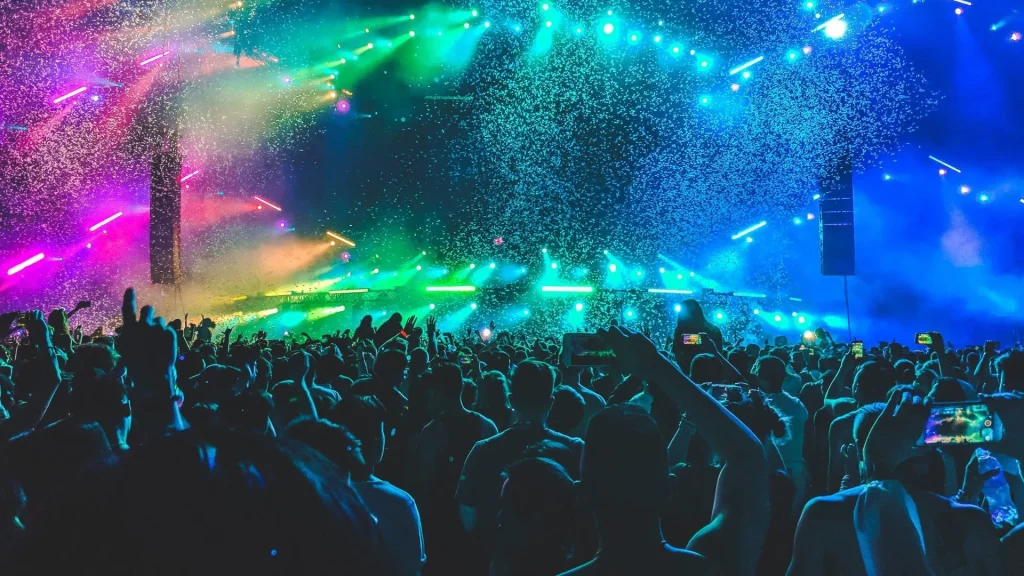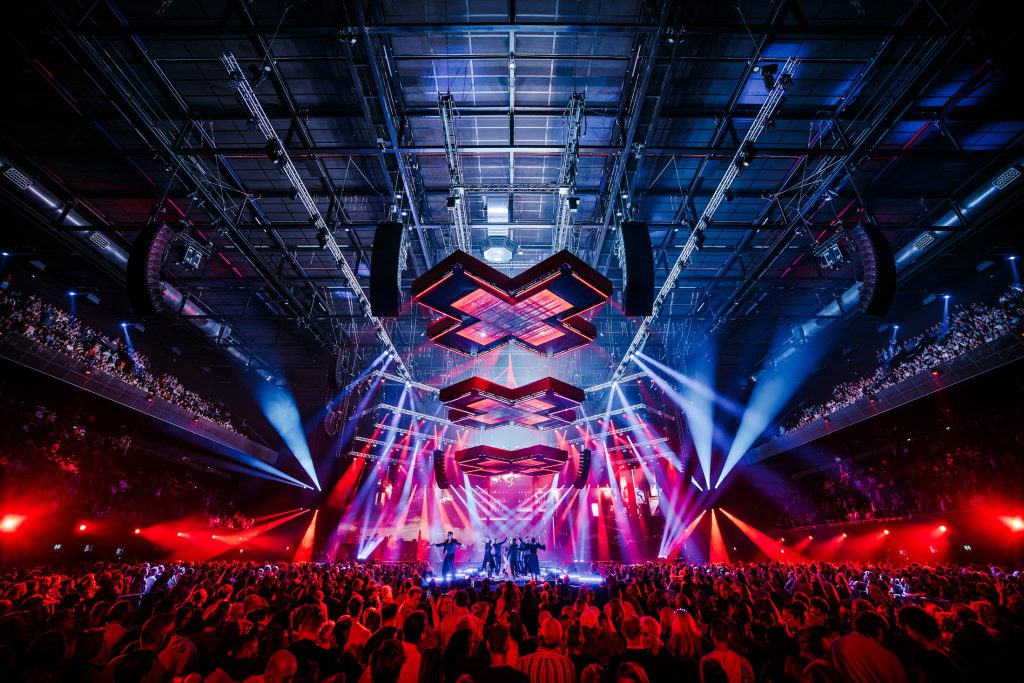After years of change and uncertainty, live music is fully back, and it looks nothing like before. In 2025, concerts have become hybrid experiences that mix technology, sustainability, and community. From AI-assisted stage design to eco-friendly touring and virtual shows, the live industry is entering a creative new era.
Here’s a look at the biggest trends shaping how artists perform, how fans attend, and how live music continues to evolve.
The Return of Real Connection

Audiences spent years watching virtual performances from their living rooms. Now, fans want real energy again, eye contact, shared sound, collective emotion. Concerts in 2025 are focused on connection, not just spectacle.
Artists are bringing back intimacy. Even stadium acts are adding smaller, fan-focused events like acoustic pop-ups or “soundcheck sessions.” The idea is simple: keep the scale, but bring back soul.
This renewed connection aligns with the authenticity movement we explored in Best Music Licensing Companies for Independent Artists, where musicians reclaim control of their work and build deeper bonds with their audience.
Sustainability Becomes a Standard
The touring industry is finally going green. Artists, venues, and promoters are under pressure to reduce waste, energy use, and carbon output.
From solar-powered stages to digital ticketing and reusable water systems, sustainable touring isn’t a PR move anymore, it’s an expectation. According to Billboard, over 60% of major tours in 2025 now include sustainability clauses in their contracts.
Eco-friendly routing is also on the rise. Artists plan tour paths that minimize travel distance and emissions, while venues partner with local transport to promote car-free attendance.
The next time you attend a concert, don’t be surprised if it feels greener, literally and ethically.
The Hybrid Show Model
The pandemic introduced livestreams, and while in-person shows have returned, virtual access remains a permanent feature. Hybrid concerts, part physical, part digital, let fans attend from anywhere.
Some artists now sell “digital front-row” tickets that include backstage streams, interactive camera control, or chat access with other viewers. It’s no longer a substitute for being there; it’s a new tier of fan experience.
This crossover between physical and virtual mirrors what we discussed in The Future of Music Streaming Platforms in 2025, the blending of digital access with real-world emotion.
Visual Immersion and AI-Driven Stages
Stage design has evolved dramatically. AI software now helps map visuals to sound in real time, syncing lighting, motion graphics, and audience responses to the rhythm of each song.
At major festivals, drones and projection mapping create massive visual landscapes, skies that move with the beat, screens that change with crowd emotion.
These AI-powered experiences expand on concepts we examined in The Rise of AI-Generated Music Videos, where technology doesn’t replace creativity, it enhances it.
The best concerts in 2025 feel less like performances and more like living art installations.
Personalized Concert Experiences
Every fan wants something unique, and now, they can have it. Personalized experiences are becoming the new VIP.
Mobile apps linked to concert tickets now send curated playlists, exclusive behind-the-scenes footage, or custom lighting synced to your seat.
Some artists even use AR (augmented reality) lenses, letting fans point their phones at the stage to unlock extra animations or lyrics floating in the air. It’s creative, futuristic, and surprisingly personal.
Small Venues, Big Impact
While stadium tours dominate headlines, the heart of live music has moved back to smaller stages. Indie artists and mid-tier acts are thriving thanks to local venues and niche festivals.
The micro-tour trend, 10 to 15 intimate shows instead of one massive arena run, lets musicians focus on community, not logistics. It also allows fans to connect more deeply, turning every gig into a memory instead of just an event.
This shift aligns with themes from Top 10 Music Artists Dominating 2025, where longevity comes from authentic fan relationships rather than hype.
Virtual Reality and Holographic Performances
VR concerts are no longer experimental. Fans can now put on headsets and attend fully immersive 3D performances that mimic real-world spaces.
Artists like Travis Scott and Grimes are already integrating holographic visuals into live sets. Some tours feature AI-generated dancers or stage elements that respond to crowd motion sensors.
What was once science fiction is now part of the tour blueprint.
Fan Collaboration and Participation
The fan-to-artist relationship is more interactive than ever. In 2025, audiences don’t just watch; they shape the performance.
Apps allow fans to vote for the next song, light color, or encore in real time. Some artists collect fan voice samples online before the show and mix them into live performances.
It’s participatory music, a reflection of how fans have become co-creators in modern entertainment. This idea connects directly to our earlier discussion in How YouTube Promotion Is Changing the Music Industry, community-driven engagement as the new creative fuel.
Tour Branding and Storytelling
Touring has become an extension of an artist’s brand identity. Every show, stage outfit, and setlist ties into a larger narrative that carries through music videos and social media.
Tours now have visual continuity, logos, symbols, story arcs, like cinematic universes. Fans follow the storyline from one city to the next, creating global cohesion that feels personal in every country.
For example, Billie Eilish’s tours now include mini-documentaries between legs, allowing fans to see growth between cities. These storytelling layers make live music feel like a shared journey, not a one-night event.
Data and Smart Ticketing
Technology isn’t just behind the scenes; it’s in the ticket, too. Smart ticketing uses blockchain and facial recognition to prevent scalping and fake entries.
Dynamic pricing models adjust based on demand, while loyalty systems reward returning fans with early access or discounts. Data analytics help artists understand audience behavior, which songs spark the biggest reactions, where fans travel from, and what cities deserve repeat stops.
As noted in The Most Anticipated Albums of 2025, data-driven creativity is shaping every corner of the industry, and live music is no exception.
Accessibility and Inclusivity
Concerts in 2025 are more inclusive than ever. Venues are redesigning layouts for better wheelchair access, audio descriptions, and sign-language interpreters.
There’s also a growing focus on neurodiverse audiences, providing quiet zones, sensory-safe lighting, and clear visual cues for those who find concerts overwhelming.
Inclusivity has become not just a compliance goal, but a cultural one.
The Rise of Sustainable Festivals
Music festivals are evolving fast. Single-use plastic bans, compostable wristbands, and local food partnerships are now common. Festival organizers also invest in carbon-offset programs, planting trees or supporting renewable projects.
This shift mirrors the eco-awareness trend we’ve seen across all music formats. It’s about making joy sustainable.
The Business Side: Fewer Gigs, Bigger Impact
Touring is expensive. Artists are responding by playing fewer but higher-impact shows, each designed for media buzz and global streaming.
This “selective touring” strategy reduces travel stress and costs while keeping demand high. It’s a practical move that also aligns with wellness-focused management styles across the industry.
Mental Health Takes the Spotlight
Finally, artists are prioritizing balance. After years of burnout headlines, touring schedules are more mindful. Wellness breaks, mental health support teams, and shorter show runs are becoming standard.
Fans appreciate it too, it’s part of the authenticity they crave. Seeing artists take care of themselves strengthens emotional connection and trust.
The Future of Live in 2025 and Beyond
Live music is no longer a single format. It’s physical, digital, visual, and emotional all at once. The concerts of 2025 show that innovation doesn’t mean losing the human touch, it means amplifying it.
Technology may drive production, but it’s still the emotion on stage that makes the night unforgettable.
For more on how technology is reshaping creativity, check out The Rise of AI-Generated Music Videos and explore how visuals, algorithms, and human connection are shaping the next era of performance. You can also visit the YMLP204 to follow every new update on music trends, innovation, and industry shifts.

